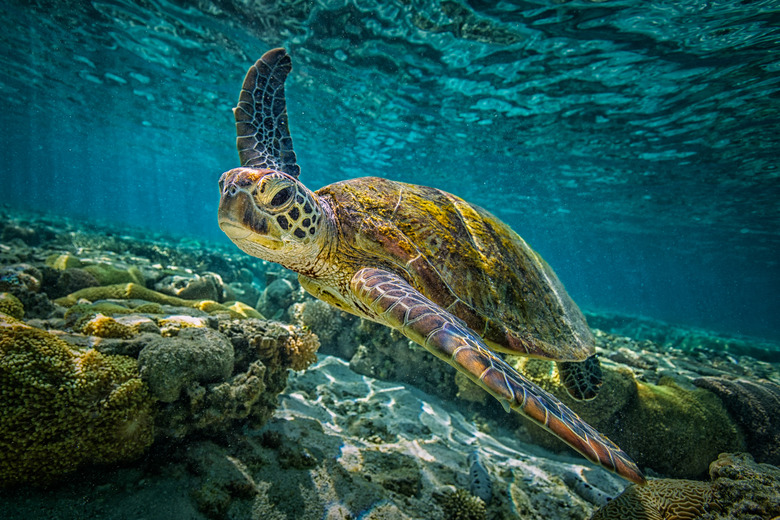List Of Things That Have Shells
Animals with shells—the majority of which are sea-based—come in a variety of shapes and sizes. People who love beach-combing commonly come across seashells, some of which might still have a sea creature in them. Just like the roof you live under, shells help house and protect animals from their environment.
Mollusks
Mollusks
Most of the seashells we know are part of a classification of animals collectively called "mollusks." Clams, mussels and the triton or trumpet shell are just some of the invertebrates that belong to the phylum Mollusca. These are creatures without any backbones that have proportioned bodies containing a head, visceral hump, mantle and foot. In most mollusks, hard shells are mounted on the visceral hump and house their internal organs. The mantle secretes a sheet of tissue made of calcium carbonate and other minerals that eventually becomes the shell during the mollusks' developmental process.
Crustaceans
Crustaceans
Crustaceans are considered the biggest collection of marine arthropods—or animals with segmentation. Lobsters, crabs, and shrimps are just some of the creatures that make up the approximately 30,000 species of crustaceans. All crustaceans have an external shell made of calcium and a protein called "chitin." The outer shell serves as protection and firm support for the muscle-attachments or joints, which allows crustaceans to move.
Turtles and Tortoises
Turtles and Tortoises
Turtles and tortoises are some of the best-known shell-dwelling creatures. The difference between them is that tortoises live on land while turtles prefer the water. Compared with the shells of mollusks and crustaceans, turtle and tortoise shells are part of their hosts endoskeletons and are actually composed of living cells, nerves and blood vessels. The shell surfaces are considered epidermal structures made of the protein keratin. The exoskeletons are made of calcium phosphate and, just like human bones, are constantly growing.
Sea Urchins
Sea Urchins
A sea urchin's shell is also known as a "test." The male shells have an attractive symmetrical design that serves as a tool for attracting females. The rigid shell is made of flat, connected calcareous ossicles, which split into 10 sections. Among these sections are five ambulacral plates, which have pierced holes where the tube feet stick out. The remaining plates without holes are called "interambulacral" areas.
Armadillos
Armadillos
Armadillos, which are related to anteaters and sloths, don't exactly have shells, but the bony plates that cover their backs, heads and and tail provide the same protection. Armadillos are the only mammals with such bony carapaces, and the structure of their shells is unique, even among reptiles and other creatures. One subspecies, the three-banded armadillo, can curl itself up inside its outer covering as a protection against predators. Armadillos live mostly in warm climates and can die during periods of unseasonably cold temperatures.
Cite This Article
MLA
Johnson, Steve. "List Of Things That Have Shells" sciencing.com, https://www.sciencing.com/list-things-shells-8009317/. 19 April 2018.
APA
Johnson, Steve. (2018, April 19). List Of Things That Have Shells. sciencing.com. Retrieved from https://www.sciencing.com/list-things-shells-8009317/
Chicago
Johnson, Steve. List Of Things That Have Shells last modified March 24, 2022. https://www.sciencing.com/list-things-shells-8009317/
